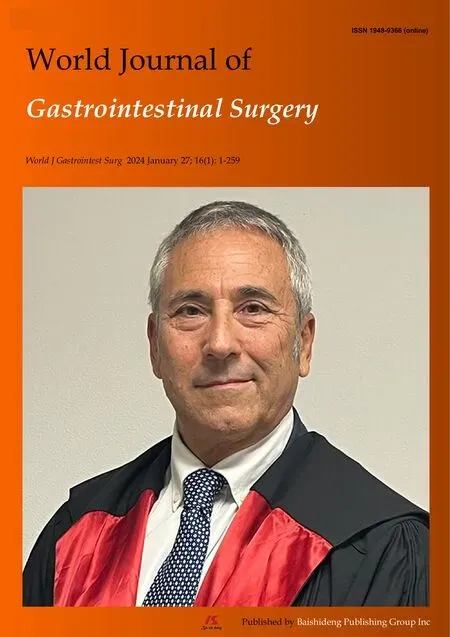Sarcopenia in cirrhotic patients: Does frailty matter while waiting for a liver transplant?
Xing-Jie Li,Kang He
Abstract Sarcopenia reflects patient frailty and should be routinely assessed due to its high prevalence in cirrhotic patients awaiting liver transplants.Pre-transplant nutritional optimization should be tailored for patients with a definitive diagnosis of sarcopenia,therefore improving functional status at transplant and reducing posttransplant mortality.Hepatologists and transplant surgeons should have raised awareness regarding sarcopenia and the reflected frailty that hinder posttransplant outcomes.The policymakers should also take into account when modifying the organ allocation model that sarcopenia or frailty might become a decisive factor in allocating organs for cirrhotic patients,in order to ensure post-transplant survival and quality of life.
Key Words: Sarcopenia;Liver transplant;Organ allocation policy;Cirrhosis;Frailty
TO THE EDlTOR
We read with great interest an original research paper by Yinet al[1],who performed a retrospective case-control study on patients who received a transjugular intrahepatic portosystemic shunt (TIPS) procedure between January 2020 and June 2021 at their center.It was evidenced that myosteatosis and sarcopenia were associated with a high incidence of overt hepatic encephalopathy in patients after the TIPS procedure[1].
We appreciate and agree with the authors’ findings and would like to further investigate into the effects of sarcopenia,a reflection of patient frailty,on cirrhotic patients listed for a liver transplant.By definition,sarcopenia refers to a decline in both quantity and quality of the skeletal muscle,presented clinically with corresponding decline in muscle strength,therefore the ability to carry out physical activity[2].It is associated with an increased likelihood of adverse outcomes.In cirrhotic patients,the prevalence of sarcopenia range between 30% and 70%,with a higher proportion in males,low body mass index patients and patients with alcoholic liver diseases[3].The pathogenesis is not clear,but it was postulated that most cirrhotic patients had been suffering from chronic decompensated end-stage liver disease with an altered catabolism,direct myotoxicity from systemic ammonia,poor nutrition status and long-term physical inactivity[4].
A meta-analysis from Tantaiet al[5] reported an approximately 2-fold higher mortality among all subgroups of cirrhotic patients with sarcopenia,comparing to those who don’t[5].To be noticed,the results also applied to patients with low model for end-stage liver disease (MELD)-Na score,which is a predictor of three-month mortality of cirrhotic patients and the current modality of prioritizing liver allocation.It is calculated based on the parameters of serum creatinine,bilirubin,international normalized ratio and serum sodium,ranging from 6 to 40.However,sarcopenia,as an independent risk factor for mortality in post-transplant patients,has not been integrated into the MELD-Na score,nor has it been accepted as an exception score.In the study by Montano-Lozaet al[6],a modified MELD-sarcopenia score was proposed[6].The patients with lower MELD scores particularly benefit from the novel model because they were traditionally deemed of low risk.It requires multicenter study with higher case number to validate a reliable and predictive model and implicate it in the clinical setting,but we do believe sarcopenia should be considered during listing and organ allocation,to prioritize patients who have poor performance status not properly reflected by MELD-Na score.
Therefore,it is of vital importance to recognize sarcopenia at listing and during pre-transplant surveillance.The gold standard for sarcopenia diagnosis is psoas muscle cross-sectional area normalized for stature (cm2/m2) at the level of L3 on abdominal computed tomography (CT) scan,also known as the L3 skeletal muscle index,although different cutoffs have been applied in previous studies[3,4].As abdominal CT scan is routinely performed in cirrhotic patients at transplant evaluation for either cancer screening or anatomical mapping,it enables a qualitative measurement and a definitive diagnosis of sarcopenia concurrently at no additional costs.Once the diagnosis is made,pre-transplant management should be advocated for to optimize those cirrhotic patients for an upcoming transplant,including nutrition clinic visits and physical therapist appointments for individualized counseling if available[7].
As mentioned above,sarcopenia is a reflection of patient frailty.While it may be logistically unrealistic to repeat an abdominal CT scan at every follow-up visit with no other clinical indications,there are various well-developed clinical assessment tools for frailty.The liver frailty index (LFI) is an objective measurement specifically developed for cirrhotic patients,which involves three easily assessed aspects of grip strength,timed chair stands,and balance testing.With a well-established cutoff,LFI significantly improves mortality prediction in cirrhotic patients compared to subjective assessment solely (0.74vs0.68;P=0.02) and is further implicated with great reproducibility in noncirrhotic populations[8,9].
We would like to emphasize that sarcopenia and frailty are both dynamic processes rather than a static status,in which continuous interval monitoring,documentation,and management could potentially optimize the overall condition of a cirrhotic patient prior to receiving an organ[10].
FOOTNOTES
Author contributions:Li XJ wrote the manuscript;He K designed the study and revised the manuscript.
Conflict-of-interest statement:All the authors report no relevant conflicts of interest for this article.
Open-Access:This article is an open-access article that was selected by an in-house editor and fully peer-reviewed by external reviewers.It is distributed in accordance with the Creative Commons Attribution NonCommercial (CC BY-NC 4.0) license,which permits others to distribute,remix,adapt,build upon this work non-commercially,and license their derivative works on different terms,provided the original work is properly cited and the use is non-commercial.See: https://creativecommons.org/Licenses/by-nc/4.0/
Country/Territory of origin:China
ORClD number:Kang He 0000-0003-4671-1337.
S-Editor:Li L
L-Editor:A
P-Editor:Li L
 World Journal of Gastrointestinal Surgery2024年1期
World Journal of Gastrointestinal Surgery2024年1期
- World Journal of Gastrointestinal Surgery的其它文章
- Novel prognostic factors after radical resection of hepatocellular carcinoma: Updating an old issue
- Prospects in the application of ultrasensitive chromosomal aneuploidy detection in precancerous lesions of gastric cancer
- Prognostic value of ultrasound in early arterial complications post liver transplant
- Added value of ratio of cross diameters of the appendix in ultrasound diagnosis of acute appendicitis
- Single-incision laparoscopic transabdominal preperitoneal repair in the treatment of adult female patients with inguinal hernia
- Predictive value of machine learning models for lymph node metastasis in gastric cancer: A two-center study
